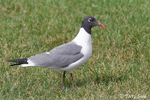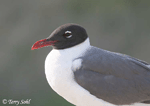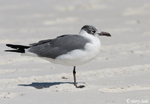| Length: 16 inches | Wingspan: 40 inches | Seasonality: Rare Visitor |
| ID Keys: Black head, white neck and underparts, dark gray back, black wingtips. | ||
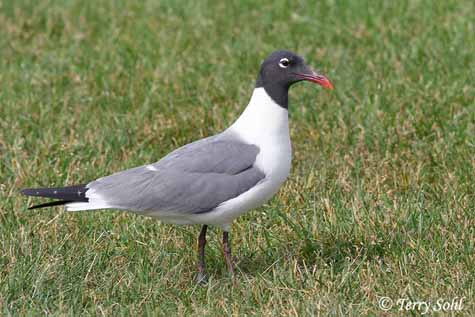 Named
for its well-known laughing call, the Laughing Gull is a common sight (and
sound) of the Atlantic and Gulf coasts of the United States. They have
the unusual habit of stealing food from Brown Pelicans, landing on their
heads and stealing fish from the Pelican's large pouch. Rarely seen
inland, the Laughing Gull is a rare visitor to the state.
Named
for its well-known laughing call, the Laughing Gull is a common sight (and
sound) of the Atlantic and Gulf coasts of the United States. They have
the unusual habit of stealing food from Brown Pelicans, landing on their
heads and stealing fish from the Pelican's large pouch. Rarely seen
inland, the Laughing Gull is a rare visitor to the state.
Habitat: Generally only found near coastal regions, only rarely venturing very far inland except in Florida and around the Salton Sea. On coasts, primarily found around beaches and salt marshes.
Diet: Small fish, insects, crustaceans, earthworms, eggs and young birds, refuse.
Behavior: Forages by walking, wading, or swimming, and occasionally by plunge-diving or dipping from the surface in flight.
Breeding: Non-breeder in South Dakota
Song: Laughing Gull Song
Migration: Summers along Atlantic and Gulf Coasts. Populations along northern part of Atlantic Coast move south in the fall, while southern U.S. populations are generally permanent residents. A true coastal bird that is only very rarely seen inland.
Interactive eBird Map: Click here to access an interactive eBird map of Laughing Gull sightings
Similar Species: Franklin's Gull, Bonaparte's Gull. See Identification Tips.
Conservation Status: Numbers were seriously depleted during the 19th century, but recovered quickly and are now stable.
Further Information: 1) USGS Patuxent Bird Identification InfoCenter, Laughing Gull
2) Audubon Guide - Laughing Gull
Photo Information: June 22nd, 2005 -- Chincoteague, Virginia -- Terry Sohl
Additional Photos: Click on the image chips or text links below for additional, higher-resolution Laughing Gull photos.
| Click on the map below for a higher-resolution view |
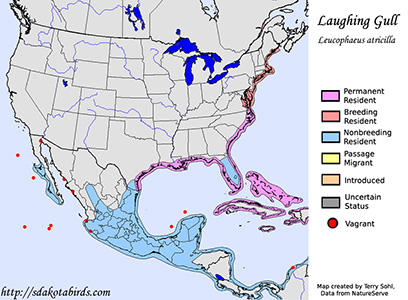 |
| South Dakota Status: Extremely rare visitor, with only a handful of records in the state. |
Additional Laughing Gull Photos
Click for a higher-resolution version of these photos
